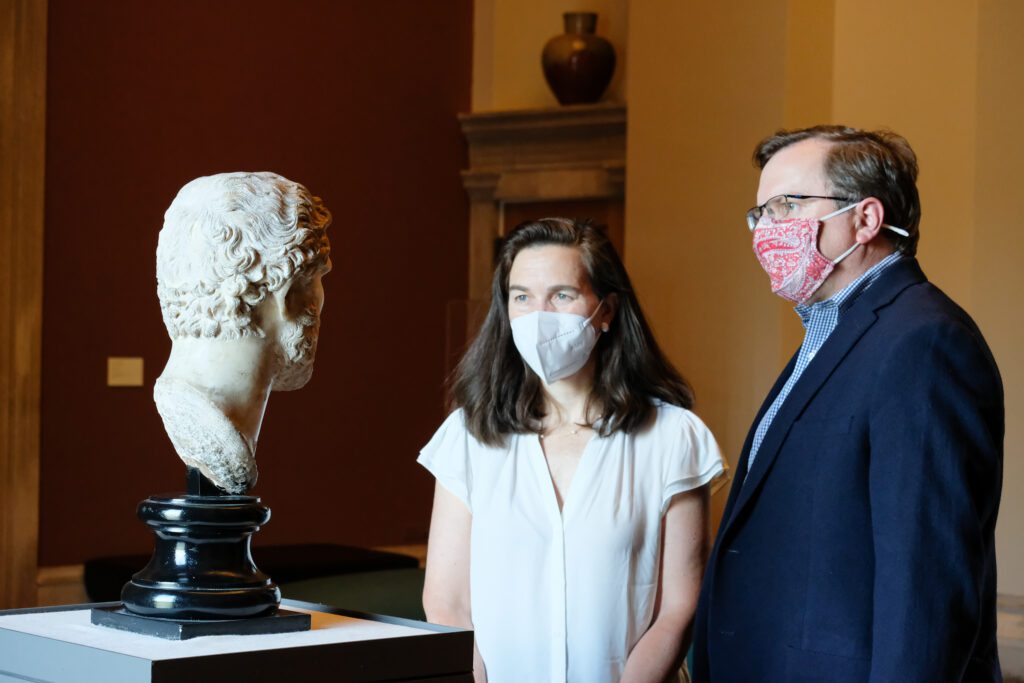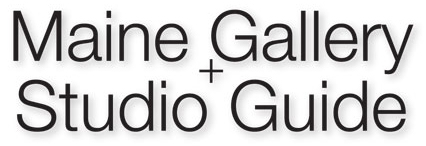
The Bowdoin College Museum of Art announced that it will reopen to the public on July 1, after more than a year of pandemic-related closure, and will present four new exhibitions.
“Re | Framing The Collection: New Considerations In European And American Art 1475–1875,” in the Museum’s Bowdoin Gallery, explores the intertwined stories of Europeans and their American descendants with Indigenous and enslaved peoples whose lives have long been erased from historical narratives.
“New Views of The Middle Ages: Highlights From The Wyvern Collection” includes over 50 works from one of the world’s premiere private collections, many of which have not been publicly presented before, covering the period from the 6th through the 16th centuries.
Finally, two student-organized exhibitions — “The Presence of The Past: Art From Central And West Africa” and “Creeping Pavement: Depictions of an Urbanizing America” — will demonstrate the strength of the museum’s role on campus and its active place in the college’s educational model.
The museum will be open to the public beginning July 1 from 11 a.m. to 5 p.m. Tuesday through Sunday. To ensure the continued health and safety of Bowdoin’s campus community, masks and social distancing will be required. Check www.bowdoin.edu/art-museum/visit/index.html for the most up-to-date information about visiting requirements.
“Our reopening exhibitions highlight the depth and breadth of our collection, as well as the value of long-term loans that support both curatorial efforts to create engaging shows and the academic study that is at the heart of our campus mission,” said Frank Goodyear, co-director of the Bowdoin College Museum of Art.
Bowdoin College Museum of Art is at 245 Maine St., Brunswick. Call 207-725-3275, or go to https://www.bowdoin.edu/art-museum for more information.
UPCOMING SHOWS
“Re | Framing The Collection: New Considerations In European And American Art 1475–1875”
In 1811, James Bowdoin III bequeathed his art collection to support the new college bearing his family’s name. But while his philanthropy has been recognized, his family’s enslavement of Africans in colonial Boston — and the dispossessing and displacement of the Wabanaki from their homelands along Maine’s Kennebec River — get less attention. This history is the jumping-off point for the Museum’s new exhibition, Re | Framing The Collection: New Considerations In European And American Art 1475–1875, which explores the intertwined stories of Europeans and their American descendants with the Indigenous and enslaved peoples whose lives have long been erased from historical narratives—including those of art history. The narrative begins with European exploration in the 15th century, followed by the actions of the United States government starting in 1783. Successive governments fought over and harvested this continent’s vast resources and, in the process, undermined Indigenous communities through disease and by force, and enslaved Africans and others for their own economic benefit.
Among the works included are Pieter van der Aa’s 1713 engraved map of the world, “Nova Orbis Terraquei Tabula Accuratissime Delineata / Mappe-Monde ou Description Generale du Globe Terrestre et Aquatique”; John Quidor’s 1832 painting “Leatherstocking’s Rescue II”; an 18th century Wabaki trade brooch and two mid-19th century baskets, all made by unidentified Indigenous artists; and Albert Bierstadt’s 1875 painting of California’s Tuolumne Meadows.
“New Views Of The Middle Ages: Highlights From The Wyvern Collection”
Also on view at Bowdoin this summer will be New Views Of The Middle Ages: Highlights From The Wyvern Collection. The exhibition includes over fifty works from one of the world’s premiere private collections, many of which have not been publicly presented before, covering the period from the 6th through the 16th centuries, with works from east Africa, West Asia and Europe. These works demonstrate the enduring relevance and influence of the medieval period on contemporary societies, from establishing rules and traditions around cross-border trade, to the ways in which expertise in artistry and manufacturing may vary from place to place, to the complex ways in which we affiliate with multiple identities based on our geographic, religious, and familial histories.
The themes it addresses include an exploration of the artistic media and techniques typical of medieval Europe; the vast networks of trade across three continents that promoted a flourishing—and evolving—artistic environment; and the ways in which medieval peoples throughout these regions used the visual arts to explore and define their own identities. Among the highlight works are: “Diptych with Saint George, and the Virgin and Child” (c. 1500), two small panel paintings bound together with Saint George on the left, painted in a style consistent with that used for icons in Ethiopia, and a painting of the Virgin and Child, in a style that evokes traditional Byzantine icons, on the right side; the “Vermicular Chasse with Saints and the Lamb of God” (c. 1185, Limoges, France), an object just 5.5 inches high that includes the complex techniques of champlevé enameling, vermiculé, and appliqué; and a 6th century brooch from present day France or Germany and made from partially gilded silver and accented with garnets.
Originally scheduled to open in September 2020, the public presentation was delayed by the Museum’s closure due to the pandemic, while an online version was launched to provide another means for viewers to experience these works. The exhibition is curated by Kathryn Gerry, Bowdoin College’s Visiting Assistant Professor of Art History. The exhibition is accompanied by a scholarly catalogue, which includes a selection of object entries written by Bowdoin current and former students who conducted research on these works under Gerry’s guidance.
“The Presence of The Past: Art From Central And West Africa”
The third exhibition on view will be The Presence of The Past: Art From Central And West Africa, which brings together works from the Museum’s collection as well as the objects on long-term loan from the Wyvern Collection. With support from exhibition organizers David Gordon, Professor of History at Bowdoin College, and Allison Martino, now Raymond and Laura Wielgus Curator of the Art of Africa, Oceania, and Indigenous Art of the Americas, The Sidney and Lois Eskenazi Museum of Art at Indiana University, students working with Professor Gordon used the Museum’s Zuckert Seminar Room to study the objects, and drew on their research and direct observation to develop the object labels throughout the exhibition.
Fundamentally, the exhibition looks to reconsider the contemporary understanding of African artistic representations and the place of Africa in a global cultural imagination. Canonical artworks from Central and West Africa — such as a 19th century Female Power Figure (Nkisi) from the Kongo peoples, or an early 20th century Sword Ornament from Akan peoples — are presented alongside works made in the same regions since the mid-twentieth century, including contemporary photography, textiles, and masks. These include Gabriel Boakye’s Adinkra cloth (2013-2015), which combines traditional symbols of the Akan peoples with modern screen-printing techniques, and Hervé Youmbi’s Two-Faced (Double Visage) mask, from his Faces of Mask series, which brings together many of the conventional materials and forms of a Bamiléké yégué mask with a visage inspired by modern and contemporary sources (in this case, the character “Ghostface,” from the film Scream, which was itself inspired by Edvard Munch’s classic, early modern painting The Scream). These juxtapositions of different historical moments and media invite viewers to explore connections across time and space—the presence of the past in modern and contemporary art and society—with a particular eye to the forms, figures, and functions of African art.
This exhibition was to open to the public in spring 2020 but was moved into an online format after it became clear that an on-campus installation would be impossible; the online version, which includes images and object labels fall all works, can be seen here.
Creeping Pavement: Depictions of an Urbanizing America
The fourth of the Museum’s new exhibitions traces the evolution of the American city as it grew into its own distinct environment and explores the many ways artists reacted to the rapid urbanization of American life. From the landscapes that foreshadow the industrialization and commercialization to come, to more recent urban views, the selected works of art examine issues at the heart of cities and highlight the many different facets of a perpetually developing urban landscape, investigating the ever-changing qualities that characterize the city today. In America, cities are places of contrast and connection: They bring people together, yet often highlight the tensions that divide. Cities are home to both the wealthy and the least privileged, and inhabitants may hail from near and far, yet all see themselves as a part of a city’s identity.
Thus, the art created when these urban centers developed offers a unique perspective on American life in the nineteenth and twentieth century. From historical works by artists such as John Marin’s etching Brooklyn Bridge and Lower New York (1913) and Lewis Hine’s photo Steel Workers on Top of the Empire State Building Mooring Mast (1930), to more modern pieces such as Yvonne Jacquette’s pastel drawing Study for World Trade Center, New York Harbor (Looking South) (1977), the featured artists encourage critical, quizzical, and ultimately lovingly looks at big cities like New York, San Francisco, and Philadelphia. These images inspire us to find continuity and to celebrate our shared humanity, even as we still grapple with the social, political, and environmental ramifications of urbanity. If recent events have demonstrated the vulnerability and even the fragility of cities and their inhabitants, these photographs from the past provide a powerful reminder of their resilience.
This exhibition was curated by members of the 2019–2020 Student Museum Collective — Sylvia Bosco ’21, Joseph Hilleary ’20, Cassie Jackson ’22, Sabrina Lin ’21, and Ben Wu ’18 — and is supported by the Becker Fund for the Bowdoin College Museum of Art.
Categories: Announcement, Brunswick, exhibitions, shows

